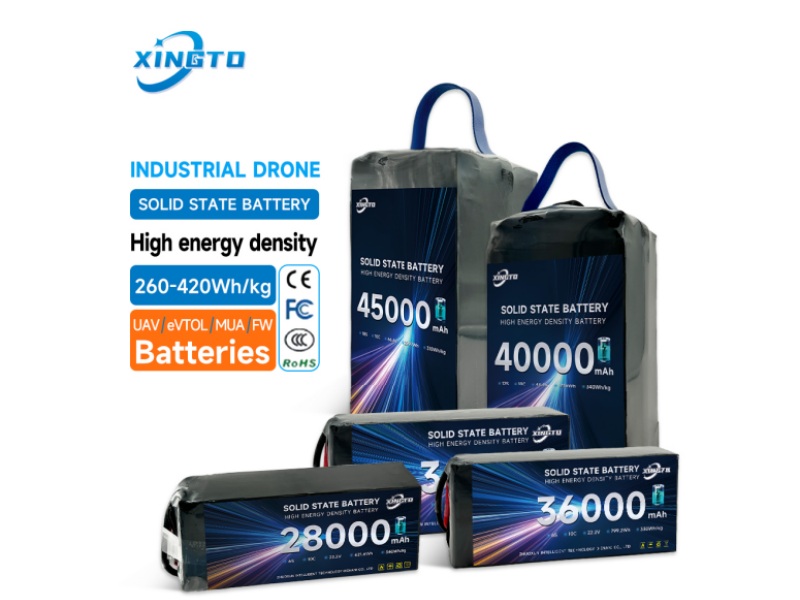As drones evolve from hobbyist gadgets to critical tools in industries like logistics, agriculture, and surveillance, battery selection becomes a pivotal factor in mission success. While both lithium-ion (Li-ion) and lithium-polymer (LiPo) batteries dominate the UAV market, their performance diverges significantly in long-range applications. This guide analyzes key technical parameters, cost structures, and real-world use cases to help operators make data-driven decisions in 2025.

1. Core Technical Differences: Energy Density vs. Power Delivery
Energy Efficiency and Flight Time
Li-ion Batteries:
- Higher Energy Density: Storing 150–450 Wh/kg versus LiPo’s 100–200 Wh/kg, Li-ion packs enable 20–30% longer flight times for weight-sensitive missions.
- Consistent Voltage Output: Minimal voltage sag under moderate loads ensures stable power for extended.
LiPo Batteries:
- Rapid Energy Discharge: Delivering burst currents with discharge rates up to 50C, LiPo batteries excel in scenarios requiring rapid acceleration or high thrust-to-weight ratios.
Weight and Form Factor
Li-ion: Cylindrical or prismatic cells offer compact designs, reducing overall drone weight—critical for long-range missions where every gram impacts efficiency. LiPo: Pouch cells allow flexible shapes to fit unconventional drone frames but often add bulk due to protective layers.
Technical Insight: For a 10 km flight, a Li-ion battery may reduce system weight by 15% compared to an equivalent-capacity LiPo pack, directly translating to longer airborne endurance.
2. Performance in Extreme Conditions
Thermal Management
- Li-ion: Generate less heat under steady loads, ideal for prolonged operations in temperate climates. However, they require thermal protection in sub-zero conditions to prevent capacity loss.
- LiPo: Prone to overheating during high-current draws; necessitate active cooling systems but perform better in cold environments due to lower internal resistance.
Durability and Lifespan
- Li-ion: Sustain 500–1,000 charge cycles with minimal capacity degradation, outperforming LiPo’s 300–500 cycles.
- LiPo: Vulnerable to swelling from overcharging or physical damage, requiring rigorous maintenance.
3. Cost Analysis: Initial Investment vs. Long-Term Value
The table below compares total cost of ownership (TCO) for a commercial drone operating 200 flights annually:
| Factor | Li-ion Battery | LiPo Battery |
|---|---|---|
| Initial Cost | 120-200 (6S 16,000mAh) | 80-150 (6S 16,000mAh) |
| Cycle Life | 500+ cycles | 300 cycles |
| Replacement Cost/Year | $40 | $90 |
| Maintenance | Low (BMS-integrated) | High (balancing, storage) |
| TCO Over 3 Years | $240 | $420 |
Key Takeaway: While LiPo batteries have a lower upfront cost, Li-ion’s longevity and reduced maintenance make them 45% more economical for long-term operations.
4. Safety and Regulatory Compliance
Risk Mitigation
Li-ion: Encased in rigid metal/plastic shells with built-in battery management systems (BMS) to prevent overcharging and short circuits. Less prone to thermal runaway.
LiPo: Soft pouches are susceptible to puncture and swelling. Require strict protocols for charging, storage, and transportation.
Transport Regulations
- Aviation authorities impose stricter rules on LiPo batteries due to higher flammability. Li-ion packs often face fewer restrictions for large-capacity deployments.
5. Optimal Use Cases: Matching Batteries to Missions
Choose Li-ion For:
- Long-Range Surveillance: Drones requiring 60+ minutes of flight time (e.g., border patrol, wildlife monitoring).
- Mapping/Surveying: Lidar-equipped UAVs needing steady power for consistent data collection.
- Delivery Drones: Weight-optimized logistics operations (e.g., Amazon Prime Air).
Choose LiPo For:
- FPV Racing: High-speed maneuvers demanding instant power bursts (100C+ discharge).
- Aerial Cinematography: Drones carrying heavy gimbals requiring agile movement.
- Short-Term Projects: Budget-conscious missions where initial cost outweighs longevity concerns.
6. Future Trends: Solid-State and AI-Optimized Batteries
Solid-State Li-ion: Currently, the highest energy density of Xingto brand solid-state lithium-ion batteries has exceeded 500+Wh/kg, and their safety is also higher. In the future, solid-state batteries with higher energy density will be a revolutionary breakthrough for long endurance drones.
AI-Driven BMS: Adaptive algorithm predicts battery health and optimizes charging mode, currently applied to some drone batteries.
Conclusion: A Balanced Decision Framework
Selecting between Li-ion and LiPo batteries hinges on prioritizing flight duration, power demands, and operational budgets. For long-range missions, Li-ion’s superior energy density and TCO make it the definitive choice. Conversely, LiPo remains unbeatable for high-agility applications. As solid-state technology matures, the gap between these chemistries will narrow—but for now, align your choice with strategic mission goals.
Pro Tip: Hybrid solutions (e.g., Li-ion main pack + LiPo booster for takeoff) are gaining traction in industrial drones, offering the best of both worlds.
For customized battery solutions, consult manufacturers xingto battery, offering tailored packs for specific UAV models.





